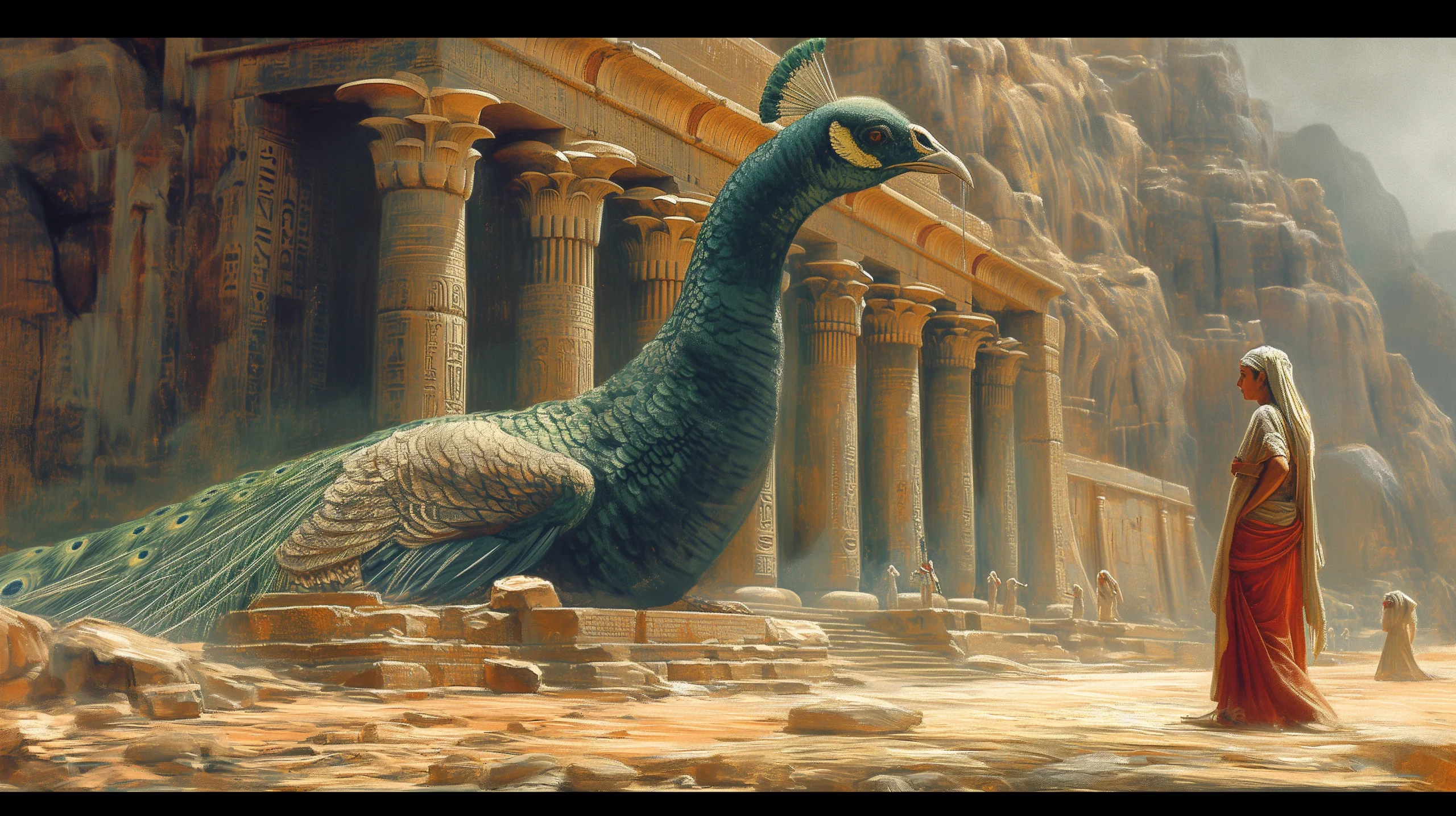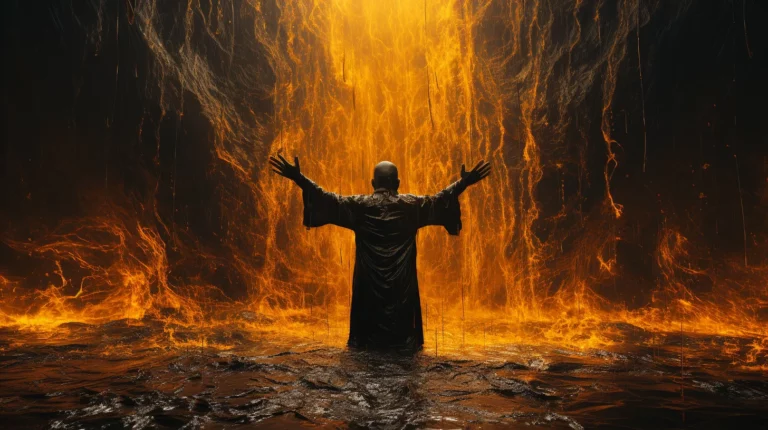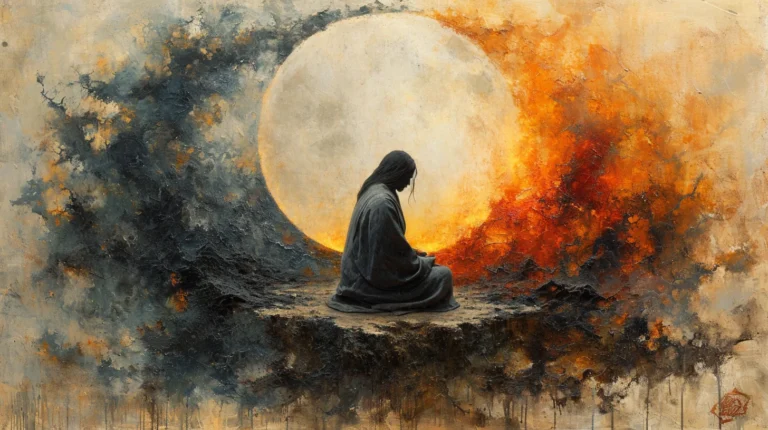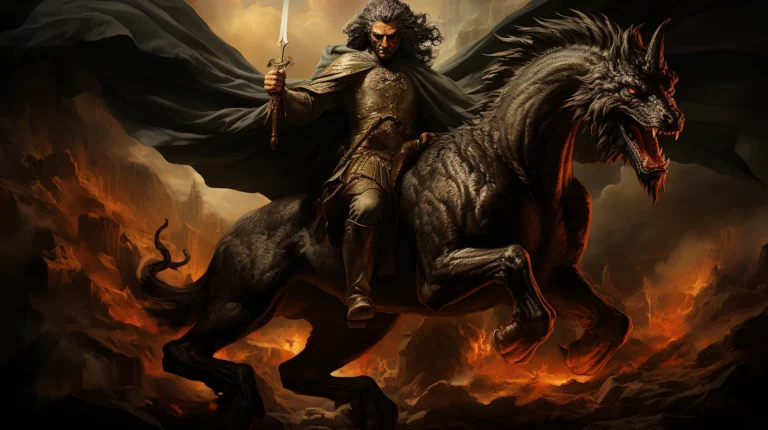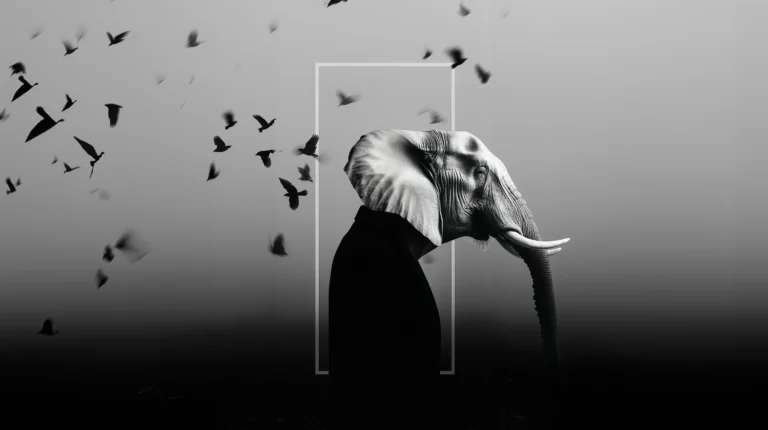Awakening the Peacock Within
Awakening the Peacock Within
Melek Taus and the Art of Individuation
Embracing the Peacock’s Wisdom
In the hidden folds of the esoteric tradition lies the tale of the Peacock Angel, Melek Taus, the first to achieve the fullness of being by the grace of the Divine. This ancient story serves as the beacon for those who walk the path of self-realization and spiritual sovereignty. To embark on this path, one must understand the sacred act of individuation, the process where a being evolves to reflect the Divine in its purest form.
Individuation is the soul’s journey towards its unique destiny, moving beyond the collective norms and unconscious patterns that define the masses. It is the arduous and noble task of becoming a monad, a singular universe unto oneself, echoing the mythic stance of Melek Taus who, unlike his peers, recognized that worship is due only to the ineffable Absolute.
The journey towards individuation demands the embracing of one’s entirety, the light and the shadow, much like the peacock displays all the hues in its feathers. The vibrant feathers, each a story, a struggle, a triumph, symbolize the full spectrum of our being. The peacock does not discriminate against its colors; likewise, the seeker must acknowledge every facet of their being. This is the first step towards unity, towards becoming a being of both the earth and the heavens, bound by neither yet belonging to both.
In the occult practice, the aspirant is encouraged to embody the qualities of the Peacock Angel, to stand firm in their truth against the tide of unconscious dogma. The ego, with its manifold illusions, is the first trial on this path. Like Melek Taus, one must resist the urge to fall into extremes. For in the world of duality, every virtue has its vice, and every light casts a shadow. The practitioner learns to navigate these dualities, not with force but with the grace of understanding, much as one would reconcile two opposing forces into a harmonious dance.
The act of loving oneself becomes a sacred ritual in this journey. It is not a narcissistic love but a profound respect for one’s divine essence and potential. It is giving oneself the importance that the Divine sees in each individual, coupled with the humility to remember one’s roots and connectedness to all things. This self-love lays the foundation for growth, for as one’s consciousness expands, so too does their capacity to serve the greater whole.
As one traverses this path, they encounter the polarities within — the anima and animus, the yin and yang of their inner world. Often, these polarities manifest as inner voices, some encouraging, others critical. The key lies not in silencing these voices but in understanding their message, integrating their wisdom, and moving forward with a newfound sense of balance.
This path is not for the faint of heart, for it is fraught with trials. The seeker may face moments where they must confront their deepest fears and doubts. Yet, these encounters are not meant to destroy but to strengthen, to forge the soul in the fires of transformation. It is a cyclical process, where each end is but the beginning of a new chapter in the soul’s eternal journey.
In this world of duality, the practitioner learns to be resilient, to rise each time they fall, understanding that the journey itself is the destination. They learn that to reach the pinnacle of their personal quest, they must accept the possibility of being struck down by the lightning of revelation, only to rise again, wiser and more aligned with their true purpose. It is a rite of passage that purges the unnecessary, leaving only the essential self.
This spiritual voyage is one of continual growth and self-discovery. It calls for an immense reservoir of mental and emotional fortitude to face the inner adversities that arise. One is to manage these internal forces not by force but by the art of inner diplomacy, seeking always to harmonize rather than to conquer.
The ultimate goal is to become like Melek Taus, not in the literal sense but in embodying the principles of self-mastery and divine connection. To achieve this state is to hold one’s universe within, to be a sovereign entity, and to contribute to the cosmic tapestry with one’s unique thread.
Thus, the first part of the guide concludes with a reminder: the path to individuation is a sacred one, filled with the wonders and perils of self-exploration. It is a journey back to the Absolute, a return to the Source from which we all emanate, and in doing so, finding the eternal dance of existence within ourselves.
Navigating the Inner Duality
The art of balancing the myriad aspects of our being is likened to walking a tightrope where the slightest sway can send us into the depths of our shadows or propel us towards the illusion of self-righteousness. Here, we explore the necessity of embracing our dual nature, not with the intent to segregate or to judge, but to understand and to bring into alignment the contrasting forces that dwell within us.
In this sacred pursuit, the practitioner is tasked with the reconciliation of opposites. This is the heart of inner alchemy where one learns to see the value in every experience, emotion, and thought. It is about transforming the base elements of our character into the gold of spiritual maturity, without denial or favoritism. The occultist knows that in the light of true knowledge, there is no good or bad in isolation; there is only the complete picture that the universe is painting through our lives.
To navigate this terrain, one must become like the Peacock Angel, who stands firm in the face of duality, unswayed by the extremes that the ego presents. One must learn to become the observer of their thoughts and emotions, to step back and view the inner drama with detachment, understanding that we are more than the sum of our parts.
This practice is not about suppressing what we deem negative, nor is it about overindulging in what we consider positive. It is about finding the middle way, a path that embodies the essence of individuation as demonstrated by Melek Taus—a path of wisdom, moderation, and self-realization.
It involves an honest assessment of oneself, embracing the journey towards becoming a complete, individuated being. This requires the willingness to confront every aspect of oneself, not with judgment, but with compassion and the intent to integrate, in the pursuit of achieving the holistic unity that Melek Taus represents.
Self-love and self-importance are revisited here, not as ends in themselves, but as tools to fortify the soul for the journey ahead. To love oneself is to commit to one’s growth and evolution. It means to honor the divine essence within and to treat oneself with the respect that such divinity deserves. This self-respect becomes the crucible in which the soul is fortified, ready to face the alchemical processes of transformation.
The journey is marked by cycles, each presenting its unique challenges and lessons. The occult practitioner understands that with each ending comes a new beginning. The cycles are not to be feared but embraced, for they signify the soul’s progression towards its ultimate destiny. The lightning strikes of insight and revelation that may at times feel like setbacks are, in truth, the universe’s way of course-correcting our path, ensuring that we stay true to our quest for individuation.
Thus, in this passage of our guide, we acknowledge the importance of maintaining a reflective consciousness, a state where one continuously observes and assesses their inner world. It is a meditative practice, where the seeker must pause and reflect upon the inner dynamics at play. By doing so, one learns to discern the subtle energies that influence our actions and reactions. This reflective practice is not a passive one; it is an active engagement with the self, a deliberate pause in the relentless march of life to ensure that every step taken is aligned with our truest intentions.
The alchemist within must also recognize the transient nature of all things. The emotions, thoughts, and circumstances that seem so permanent are but fleeting clouds in the vast sky of our existence. This understanding allows one to approach life’s vicissitudes with a calm resilience, to face the storms without being uprooted from the center of peace within.
In this work of balancing, one is also called to practice the ancient art of mental fortitude. This is not the harsh discipline of the ascetic but the gentle strength of the sage who knows that true power lies in flexibility and adaptability. Mental strength in this context is the ability to hold one’s ground amid the flux of internal and external forces, to remain centered in the whirlwind of life’s ever-changing scenes.
The guide invites the seeker to embark on the noble quest of inner harmony. It is a call to embrace the full spectrum of our being, to integrate the lessons hidden within every aspect of ourselves, and to move forward with a balanced stride on the path of spiritual evolution. It is here, in the crucible of our own hearts, that we find the alchemy that transforms the lead of our baser selves into the gold of enlightened consciousness.
Cultivating the Monad Within
In the occult tradition, the culmination of individuation is the realization of the monad — the understanding that within each of us lies a universe as vast and complex as the cosmos outside. This realization is not the end, but rather the continuous unfolding of the soul’s potential, an eternal journey of becoming.
The seeker who reaches this stage has navigated the dualities within and has embraced the lessons of balance. Now, they stand at the threshold of a profound truth: the divine spark within is not just a fragment of the Divine but a complete hologram, containing all the possibilities of the cosmos.
This stage of the journey calls for the integration of all the previous lessons. It is about living with the awareness that one is a microcosm of the macrocosm, mirroring the universe in every thought, action, and moment of stillness. The seeker must now live with the conscious intent of being a creator within their own right, shaping their reality with the knowledge and wisdom gained through their trials and triumphs.
The concept of the monad also brings with it the responsibility of self-sovereignty. To be a monad is to be self-governing, self-sustaining, and self-aware. It is to recognize that while we are interconnected with all of existence, our first duty is to govern the inner kingdom with justice, wisdom, and compassion.
In this self-governance, there is no room for the religious unconscious dogma that once diverted the seeker from their true path. The monad, in its wisdom, sees through the illusions of fear, desire, and the sense of separation perpetuated by such dogmas that once appeared insurmountable. There is a profound understanding that each challenge faced, every shadow integrated, and every cycle completed was a necessary step toward this grand realization, moving beyond the confines of narrow religious beliefs into a broader, more inclusive understanding of the spiritual journey.
As the monad, the seeker becomes a beacon of light, not just for themselves but for others on the path. The wisdom and knowledge gained are not to be hoarded but shared, for the evolution of one monad contributes to the evolution of the collective consciousness.
The journey of the monad is infinite, marked by cycles of creation, preservation, and transformation. Each cycle brings deeper insights, more profound peace, and a greater sense of unity with the All. The lightning strikes of revelation that once seemed like harbingers of destruction are now welcomed as the harbingers of renewal and growth.
The seeker understands that the world of duality is a divine play, a cosmic dance in which they are both the dancer and the dance itself. They learn to flow with the rhythms of the universe, embracing each moment as an opportunity to express their divine nature.
Continue the journey with an open heart and an expansive consciousness. It is to live with the knowledge that the work is never truly finished, that with each breath, we have the chance to co-create with the Divine, to weave our thread into the tapestry of existence with mindfulness and grace.
The path of the monad is the path of eternal becoming, a journey without end, where the destination is the journey itself, and each step is a homecoming to the heart of the Divine.
Embracing Our Inner Melek Taus
In the conclusion of this guide, we return to the core from which our journey began: the story of Melek Taus, the Peacock Angel, the first spiritual being to achieve individuation. This tale encapsulates the essence of our quest — to reach a state of authenticity and self-realization, fully conscious and aligned with the Absolute. Like Melek Taus, we are reminded that the only entity worthy of our worship and devotion is the ineffable Absolute, the ultimate reality that underlies all existence.
As seekers on this path, we are encouraged to wear our complexities with pride, much like the peacock displays its resplendent feathers. Each hue and color represents the various aspects of ourselves, both shadow and light, that we must accept and integrate on our path towards unity. The individuation process is not about reaching a state of perfection but about embracing our entire being and acknowledging our personal universe within.
The guide has led us through the understanding that in the world of duality, we must navigate the extremes, finding balance and harmony within ourselves. We have learned the importance of self-love and self-importance — not as acts of ego, but as affirmations of our worth and our journey towards the divine. To value oneself is to honor the divine spark within, nurturing it to grow and expand.
We have also been shown that this journey is one of continual opposition and reconciliation, requiring immense mental strength and inner fortitude. Like Melek Taus, we face our inner anima or animus, not with the intent to destroy it, but to understand and integrate its power. In doing so, we prevent ourselves from being consumed by our darker aspects, ensuring that we remain masters of our inner world.
The guide concludes with a reminder that the journey is cyclical and eternal. There will be moments when we feel struck by the proverbial lightning, moments that may bring us full circle to the beginning. Yet, we must not fear these moments of apparent setback. Instead, we embrace them as opportunities for growth, for rest, and for reflection. Each cycle brings us closer to our true essence and allows us to prepare for the next phase of our spiritual evolution.
This is the world of duality, a realm where the journey itself is the destination. The completion of one cycle is but the commencement of another. As we move forward, we carry with us the wisdom of Melek Taus, the resilience of the peacock, and the understanding that within us lies the potential to become a monad, a sovereign universe unto ourselves, reflective of the grandeur of the Absolute. In this recognition, we find our true purpose and the unending path of our soul’s evolution.
Melek Taus and the Vow to the Absolute
In the dawn of time, under celestial skies,
Stood Melek Taus, with fire in his eyes.
Before Adam, I shall not bow,
For only the Absolute, to You I vow.
Oh, the All, the Eternal Flame,
Beyond the stars, unknown by name.
In Your vastness, my spirit soars,
In Your truth, my heart implores.
No creation matches Your might,
In Your infinity, I find the light.
Oh, the Ineffable, the Ultimate One,
In Your mystery, all is undone.
To the formless, to the unseen,
In Your essence, I am keen.
You are the worship, the timeless love,
Oh, unknown, in heavens above.
Melek Taus knew, in wisdom so rare,
Only the Absolute is beyond compare.
In Your presence, all else fades,
In Your reality, eternity wades.

